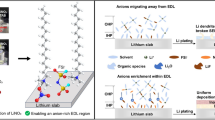Abstract
Most important advances of the last years in research and development of oxygen ion transport membrane (ITM) materials based on solid or liquid Bi2O3 are briefly given. Special attention is paid to the transport properties of novel NiO/δ-Bi2O3 and In2O3/δ-Bi2O3 ceramic and ZnO/ Bi2O3 solid/liquid composites. These composites show promise for use as ITM with the oxygen permeation rate comparable with that of the state-of-the-art membrane materials. The in situ Bi2O3 melt crystallization and grain boundary wetting methods of formation of the gas-tight composites are considered.














Similar content being viewed by others
References
A.C. Bose, G.J. Stiegel, P.A. Armstrong, B.J. Halper, and E.P. Foster: Progress in ion transport membranes for gas separation application, In Inorganic Membranes for Energy and Environmental Application, A.C. Bose, ed. (Springer, New York, USA, 2009) p. 3, 26.
X. Zhu and W. Yang: Composite membrane based on ionic conductor and mixed conductor for oxygen separation. AIChE J. 54, 665 (2008).
V.V. Belousov and S.V. Fedorov: Accelerated mass transfer involving the liquid phase in solids. Russ. Chem. Rev. 81, 44 (2012).
S.V. Fedorov, V.V. Belousov, and A.V. Vorobiev: Transport properties of BiVO4–V2O2 liquid-channel grain-boundary structures. J. Electrochem. Soc. 155, F241 (2008).
V.V. Belousov, S.V. Fedorov, and A.V. Vorobiev: The oxygen permeation of solid/melt composite BiVO4–10 wt.% V2O2 membrane. J. Electrochem. Soc. 158, B601 (2011).
W.H. Isalski: Separation of Gases (Clarendon Press, Oxford, 1989).
R.T. Yang: Gas Separation by Adsorption Processes (Butterworth, Boston, 1987).
H.P. Hsieh: New membrane materials and processes for separation. AIChE Symposium Series, No 261, v. 84, 1988 (edited by K.K. Sirkar and D.R. Lloyd).
N. Toshima and H. Asanuma: Porous Polymer Complexes for Gas Separation (chapter 5). Polymers for gas separation, N. Toshima, ed. (VCH, Weinheim, 1992).
H.J.M. Bouwmeester, H. Kruidhof, and A.J. Burggraaf: Importance of the surface exchange kinetics as rate-limiting step in oxygen permeation through mixed-conducting oxides. Solid State Ion. 72, 185 (1994).
B.A. Van Hassel: Oxygen transfer across composite oxygen transport membranes. Solid State Ion. 174, 253 (2004).
H.A. Harwig and A.G. Gerards: Electrical properties of the α, β, γ, and δ phases of bismuth sesquioxide. J. Solid State Chem. 26, 265 (1978).
P.D. Battle, C.R.A. Catlow, J. Drennan, and A.D. Murry: The structure and properties of the oxygen conducting δ phase of Bi2O3. J. Phys. C 16, L561 (1983).
P.D. Battle, C.R.A. Catlow, A.V. Chadwick, P. Cox, G.N. Greaves, and L.M. Moroney: Sesquioxides with the fluorite structure. J. Solid State Chem. 63, 8 (1986).
S.K. Blower and C. Graves: The structure of γ-Bi2O3 from powder neutron diffraction data. Acta Crystallogr. C44, 587 (1988).
H.A. Harwig: On the structure of bismuth sesquioxide: α-, β-, γ-, and δ- phase. Z. Anorg. Allg. Chem. 444, 151 (1978).
H.A. Harwig and J.W. Weenk: Phase relation in bismuth sesquioxide. Z. Anorg. Allg. Chem. 444, 167 (1978).
H.A. Harwig and A.G. Gerards: The polymorphism of bismuth sesquioxide. Thermochim. Acta 28, 121 (1979).
N. Jiang and E.D. Wachsman: Structural stability and conductivity of phasestabilized cubic bismuth oxide. J. Am. Ceram. Soc. 82, 3057 (1999).
T. Takahashi, H. Iwahara, and T. Arao: High oxide ion conduction in sintered oxide of the Bi2O3-Y2O3 system. J. Appl. Electrochem. 5, 187 (1975).
T. Takahashi, T. Esaka, and H. Iwahara: High oxide ion conduction in sintered oxide of the Bi2O3-Gd2O3 system. J. Appl. Electrochem. 5, 197 (1975).
M.J. Verker and A.J. Burggraaf: High oxide ion conduction in sintered oxide of the Bi2O3-Dy2O3 system. J. Electrochem. Soc. 128, 75 (1981).
E.D. Wachsman, G.R. Ball, N. Jiang, and D.A. Stevenson: Structural and defect studies in solid oxide electrolytes. Solid State Ion. 52, 213 (1992).
K. Fung and A. Virkar: Phase stability, phase transformation kinetics, and conductivity of Y2O3-Bi2O3 solid electrolyte containing aliovalent dopants. J. Am. Ceram. Soc. 74, 1970 (1991).
T. Takahashi and H. Iwahara: Oxide ion conductors based on bismuth sesquioxide. Mater. Res. Bull. 13, 1447 (1978).
E.D. Wachsman, S. Boyapati, M.J. Kaufman, and N. Jiang: Modelling of ordered structures of phase-stabilized cubic bismuth oxide. J. Am. Ceram. Soc. 83, 1964 (2000).
N. Jiang, R.M. Buchanan, F.E.G. Henn, D.A. Stevenson, and E.D. Wachsman: Aging phenomenon of stabilized bismuth oxide. Mater. Res. Bull. 29, 247 (1994).
V.V. Belousov, V.A. Schelkunov, S.V. Fedorov, I.V. Kulbakin, and A.V. Vorobiev: Oxygen-permeable In2O3-55 wt.% δ-Bi2O3 composite membrane. Electrochem. Commun. 20, 60 (2012).
V.V. Belousov, V.A. Schelkunov, S.V. Fedorov, I.V. Kulbakin, and A.V. Vorobiev: Oxygen-permeable NiO-54 wt.% δ-Bi2O3 composite membrane. Ionics 18, 787 (2012).
I.V. Kul’bakin, V.V. Belousov, S.V. Fedorov, and A.V. Vorobiev: Solid/melt ZnO–Bi2O3 composites as ion transport membranes for oxygen separation. Mater. Lett. 67, 139 (2012).
J. Hong, P. Kirchen, and A.F. Ghoniem: Numerical simulation of ion transport membrane reactors: oxygen permeation and transport and fuel conversion. J. Membr. Sci. 71–85, 407–408, (2012) doi:10.1016/j.memsci.2012.03.018.
J. Hong, P. Kirchen, and A.F. Ghoniem: Interactions between oxygen permeation and homogeneous-phase fuel conversion on the sweep side of an ion transport membrane. J. Membr. Sci. 428, 309 (2013).
M.J. Shin and J.H. Yu: Oxygen transport of A-site deficient Sr1−xFe0.5Co0.5O3−δ (x = 0–0.3) membranes. J. Membr. Sci. 40, 401–402 (2012).
A.A. Yaremchenko, C. Buysse, V. Middelkoop, F. Shijkers, A. Buekenhoudt, J.R. Frade, and A.V. Kovalevsky: Impact of sulphur contamination on the oxygen transport mechanism through Ba0.5Sr0.5Co0.8Fe0.2O3−δ: relevant issues in the development of capillary and hollow fibre membrane geometry. J. Membr. Sci. 428, 123 (2013).
Yu. F. Kargin: Phase equilibrium in Bi2O3-NiO system. Russ. J. Inorg. Chem. 39, 2079 (1994).
Yu. F. Kargin: Phase equilibrium in Bi2O3-M2O3 (M–Sc, In and Tl) systems. Russ. J. Inorg. Chem. 45, 1553 (2000).
G.P. Guha, S. Kunej, and D.J. Suvorov: Phase equilibrium relations in binary system Bi2O3-ZnO. J. Mater. Sci. 39, 911 (2004).
R.M. German, P. Suri, and S.J. Park: Review: liquid-phase sintering. J. Mater. Sci. 44, 1 (2009).
V.V. Belousov: Grain boundary wetting in ceramic cuprates. J. Mater. Sci. 40, 2361 (2005).
V.V. Belousov: Surface ionics: a brief review. J. Eur. Ceram. Soc. 27, 3459 (2007).
V.V. Belousov: Grain boundary wetting in ceramic materials. Colloid. J. 66, 121 (2004).
V.V. Belousov: Wetting of grain boundaries in cuprate ceramics. Inorg. Mater. 39, 82 (2003).
V.V. Belousov: Surface energy of bismuth cuprate. J. Supercond. 15, 207 (2002).
D.R. Clarke: Varistor ceramics. J. Am. Ceram. Soc. 82, 485 (1999).
R.H. French: Origins and applications of London dispersion forces and Hamaker constants in ceramics. J. Am. Ceram. Soc. 83, 2117 (2000).
V.V. Belousov and A.A. Klimashin: Catastrophic oxidation of copper: a brief review. Metall. Mater. Trans. A 43A, 3715 (2012).
V.V. Belousov: Rapid nondiffusional penetration of oxide melts along grain boundaries of oxide ceramics. J. Am. Ceram. Soc. 82, 1342 (1999).
V.V. Belousov: Catastrophic oxidation of metals. Russ. Chem. Rev. 67, 563 (1998).
V.V. Belousov: Electrochemical mechanism of hot corrosion of Bi2O3-deposited copper. Corros. Sci. 52, 68 (2010).
V.V. Belousov: Liquid-channel grain-boundary structures. J. Am. Ceram. Soc. 79, 1703 (1996).
V.V. Belousov: Liquid-channel grain-boundary structures with ionic conduction. Russ. J. Electrochem. 31, 1240 (1995).
R.J. Xie, M. Mitomo, and G.D. Zhan: Superplasticity in a fine-grained beta-silicon nitride ceramic containing a transient liquid. Acta Mater. 48, 2049 (2000).
P. Kofstad: Electrical Conductivity, Nonstoichiometry and Diffusion in Binary Metal Oxides (Wiley, New York, 1972).
T. Bak, J. Nowotny, M. Rekas, C.C. Sorrell, P.A. Banda, and W. Wolodarski: Electrical conductivity of indium sesquioxide thin film. J. Mater. Sci. 13, 571 (2002).
J. Feinleib and D. Adler: Band structure and electrical conductivity of NiO. Phys. Rev. Lett. 21, 1010 (1968).
N.G. Eror and J.B. Wagner: Electrical conductivity of single crystalline nickel oxide, Phys. Status Solidi 35, 641 (1969).
D.A. Mac Do’nail and P.W.M. Jacobs: On the lattice parameters of some sesquioxides with the fluorite structure. J. Solid State Chem. 84, 183 (1990).
N.M. Sammes, G.A. Tompsett, H. Nafe, and F. Aldinger: Bismuth based oxide electrolytes structure and ionic conductivity. J. Eur. Ceram. Soc. 19, 1801 (1999).
P. Shuk, H.D. Wiemhofer, and W. Gopel: Oxide ion conducting electrolytes based on Bi2O3. Solid State Ion. 89, 179 (1996).
K. Laurent, G.Y. Wang, S. Tusseau-Nenez, and Y. Leprince-Wang: Structure and conductivity studies of electrodeposited δ-Bi2O3. Solid State Ion. 178, 1735 (2008).
S. Hull: Superionic: crystal structures and conduction processes. Rep. Prog. Phys. 67, 1233 (2004).
M. Yashima and D. Ishimura: Crystal structure and disorder of the fast oxide-ion conductor cubic Bi2O3. Chem. Phys. Lett. 378, 395 (2003).
D. Music, S. Konstantinidis, and J.M. Schneider: Equilibrium structure of δ-Bi2O3 from first principles. J. Phys.: Condens. Mater. 21, 175403 (2009).
G. Gattow and H. Schroder: Structure of high-temperature δ-Bi2O3. Z. Anorg. Allg. Chem. 318, 176 (1962).
B.T.M. Willis: The anomalous behavior of the neutron reflexion of fluorite. Acta Crystallogr. 18, 75 (1965).
C. Wagner: Theory of tarnishing process. Z. Phys. Chem. 21B, 25 (1933).
Y. Waseda and J.M. Toguri: The Structure and Properties of Oxide Melts (World Scientific, Singapore, 1998).
A. Janotti and C.G. Van de Walle: Fundamentals of zinc oxide as a semiconductor, Rep. Prog. Phys. 72, 1 (2009).
L. Liu, J. Xu, D. Wang, M. Jiang, S. Wang, B. Li, Z. Zhang, D. Zhao, C.X. Shan, B. Yao, and D.Z. Shen: p-Type conductivity in N-doped ZnO: the role of the NZn-VO complex. Phys. Rev. Lett. 108, 215501 (2012).
H. Wang, A. Feldhoff, and J. Caro: A cobalt-free oxygen-permeable membrane based on the perovskite-type oxide Ba0.5Sr0.5Zn0.2Fe0.8O3−δ. Adv. Mater. 17, 1785 (2005).
A.V. Kovalevsky: Processing and oxygen permeation studies of asymmetric multilayer Ba0.5Sr0.5Co0.8Fe0.2O3−δ membranes. J. Membr. Sci. 380, 68 (2011).
J.E. Ten Elshof, H.J.M. Bouwmeester, and H. Verweiy: Oxidative coupling methane in a mixed-conducting perovskite membrane reactor. Appl. Catal. A 130, 195 (1995).
A.A. Yaremchenko, V.V. Kharton, A.A. Valente, F.M.M. Snijkers, A.L. Cooymans, and F.M.B. Marques: Oxygen permeability, thermal expansion and stability of SrCo0.8Fe0.2O3−δ–SrAl2O4 composites. Solid State Ion. 178, 1205 (2007).
V.V. Kharton and A.A. Yaremchenko: Perovskite-type oxides for hightemperature oxygen separation. J. Membr. Sci. 163, 307 (1999).
H.W. Brinkman, H. Kruidhof, and A.J. Burggraaf: Mixed conductivity yttrium-barium-cobalt-oxide for high oxygen permeation. Solid State Ion. 68, 173 (1994).
J.W. Stevenson, T.R. Armstrong, R.D. Carneim, L.P. Pederson, and W.J. Weber: Electrochemical properties of mixed-conducting perovskites La1−xMxCo1−yFeyO3−δ (M–Sr, Ba and Ca). J. Electrochem. Soc. 143, 2722 (1996).
M.A. Pena and J.L.G. Fierro: Chemical structures and performance of perovskite oxides. Chem. Rev. 101, 1981 (2001).
S. Lee: Mechanical properties and structure stability of perovskite type, oxygen-permeable, dense membranes. Desalination 193, 236 (2006).
J. Sunarso, S. Baumannb, J.M. Serrac, W.A. Meulenbergb, S. Liua, Y.S. Lind, and J.C. Diniz da Costaa: Mixed ionic-electronic conducting (MIEC) ceramic-based membranes for oxygen separation. J. Membr. Sci. 320, 13 (2008).
A.V. Chadwick: Nanotechnology: solid progress in ion conduction. Nature 408, 925 (2000).
V.V. Belousov: High temperature solid/melt nanocomposites. JETP Lett. 88, 297 (2008).
ACKNOWLEDGMENTS
We thank RFBR and Presidium of the RAS for financial support.
Author information
Authors and Affiliations
Corresponding author
Rights and permissions
About this article
Cite this article
Belousov, V.V. Oxygen-permeable membrane materials based on solid or liquid Bi2O3. MRS Communications 3, 225–233 (2013). https://doi.org/10.1557/mrc.2013.41
Received:
Accepted:
Published:
Issue Date:
DOI: https://doi.org/10.1557/mrc.2013.41




